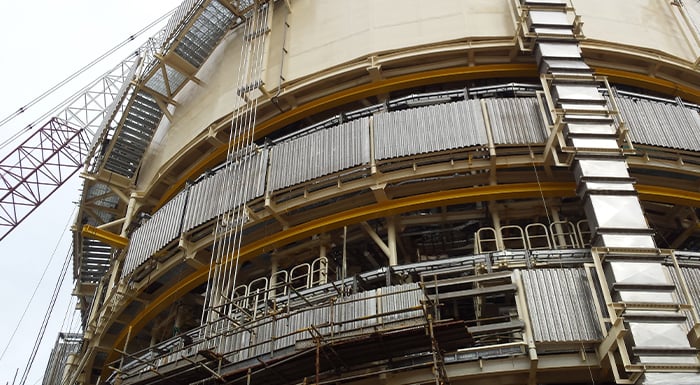
To ensure the safety of personnel and special equipment in on- and offshore facilities or technical buildings, fire and explosion proof compartments are made. This prevents fire from spreading quickly and limits the effect of explosions. Van Dam is specialized in developing fire and blast rated walls of these compartments. But there are more possibilities to increase fire safety within the compartments, and thus the safety of personnel and equipment.
In this blog I will discuss the application of stand-alone fire and jet fire walls, how they increase safety and how Van Dam can help you with this.
Function of stand-alone wall
The function of a stand-alone (jet) fire wall is to separate the fire from the rest of the room. If there are several transformers or machines in one room, it is advisable to place a partition between them. In this way a catastrophe in one piece of equipment does not lead to damage to other machines.
Van Dam's stand-alone walls are made of carbon steel or stainless steel, this depends on the type of machinery in the room and the type of fire hazard.
Security is increased by limiting the spread of fire, increasing the required response time for extinguishing the fire, and the partition walls also offer protection to other machines in the room.
Fire wall protection
The fire wall can be made of carbon steel S235 or Stainless Steel S316L and is designed to stop immediate flashover. The wall acts as a barrier and protects equipment and employees.
A cellulose or hydrocarbon fire (depending on the fire hazard) can quickly reach a temperature of 800 to 1100 degrees, respectively, a temperature that a partition wall must be able to withstand. This is no problem with use of a Van Dam fire wall. We can accommodate Hydrocarbon fires up.
The wall that can handle a Jet fire
A jet fire is a concentrated flame, for example due to a leak in a fuel line. Because of the concentrated effect, the damage can be extensive. The temperature of a jet fire is also higher (depending on the type of fuel, pressure and fuel flow can reach up to 1350 degrees). With a normal fire wall, a jet fire would burn a hole in the mild steel wall at a rate of 2 millimetre (5/64’’) every 10 minutes!
The jet fire wall is solemnly made of stainless steel 316L and is suitable to withstand higher temperatures, making it resistant to the concentrated effect of a jet fire, thus securing the integrity of the wall system. It is a so-called corrugated wall (https://blog.van-dam.nl/corrugated-steel-walls-the-best-solution-in-blast-resistant-design). The design of the Jet fire walls can be adjusted to specific wishes and the environment, taking into account the flammable liquid that the machine uses and what pressure and temperature the wall must be able to handle. When there is a risk of explosion, the thickness of the wall can be adjusted. Van Dam’s added value is the fact that we specialize in optimization of the thickness and angles of the corrugations used to ensure the specific conditions and requirements to be met at all time and in a cost effective manner.
Lightweight partition walls
Fire and blast walls are optimized to be as light as possible (especially in an offshore environment, added weight is often to be minimized, this is Van Dam’s speciality). The design of a wall is governed by the type of fire hazard (duration, temperature), and explosion level. This ensures that the design is as light as possible.
Insulation of the walls
The fire walls and the jet fire walls are insulated if necessary. Insulation in fire and blast rated walls has several beneficial characteristics, such as acoustic performance, passive fire protection and temperature control. Insulation is used here to keep the temperature on the cold side of the wall within predefined norms. Due to the fire, the temperature in the room will increase dramatically within minutes, but the insulation ensures that the temperature on the other side of the wall is limited.
Outdoors
Another application of a fire walls is the so called radiation panel. Which consists of a solid or perforated corrugated sheet SS316L.
These type of walls are used to protect the main Oil pipeline that can run alongside hazardous areas on the refinery or tank farm. It is a very cost-effective way of reducing the heat flux radiation toward the main pipeline in case of a fire event. Thus allowing personnel a window to close the main valves without getting exposed to the heat of the fire.
The heat flux can be reduced up to 97% (which is optimized and calculated via Van Dam engineers to ensure the desired maximum heat flux). Additionally, a design with perforations can be used. This will allow fire fighters and or personnel to see through the wall, to ensure their own safety at all times.
Provide extra fire safety with stand-alone (jet) fire walls
Whether it is inside or outside, the stand-alone fire walls and jet fire walls from Van Dam provide extra fire safety and protect your employees and equipment optimally. The walls are made of carbon steel or stainless steel and can handle cellulose fires, hydrocarbon fires, or even jet fires.
Want to take a look at high quality fire solutions, such as walls, doors and windows? Download the eBook Van Dam’s product range!






